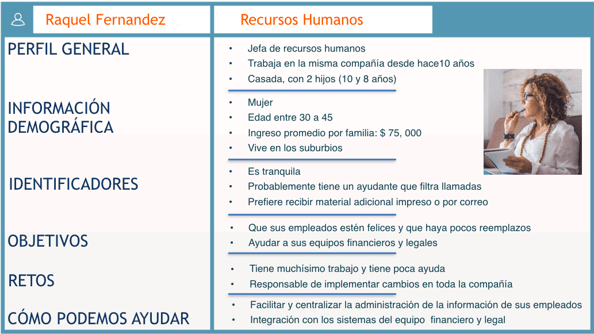If you've been close to the marketing world in recent years, you've probably heard the term "Buyer Persona." It's casually thrown around as if everyone has one and knows what it is.
But that's not the case. If you've landed on this post after a covert search for "What is a Buyer Persona?" and you're waiting to find out what the hell everyone is talking about, you've come to the right place.
First, let's get the definition out of the way.

What is a buyer persona?
A Buyer Persona is a research-based profile that represents a target customer. The Buyer Persona describes who your ideal customer is, how their days look like, the challenges they face, and how they make decisions.
It's common to have multiple buyer personas for a company; for example, if the end user of your product needs approval from others before making a purchase, each person involved in that decision is a separate persona. They will have different criteria for evaluating your product, and you'll need different strategies to address those needs.
Buyer personas are sometimes called customer or marketing personas or profiles, but whatever term you use, the purpose is the same. Buyer personas help businesses understand and empathize with their customers so they can do a better job of acquiring and serving them.
Why are buyer personas important?
Buyer personas help ensure that all activities involved in acquiring and serving your customers are tailored to the needs of the target buyer.
It may seem like an obvious thing, but it's not as simple as it seems. If you pay close attention to how companies present themselves, you'll start to notice that many of them begin by talking about what they do, not what the customer needs.
This puts them at odds with how people make decisions. When choosing a product or service, people naturally gravitate towards companies they know and trust. And the best way to build trust is by showing genuine understanding and concern for the other person, in this case, your customers.
Earning trust as a business requires a subtle but important shift in how you present yourself. First, show your potential customers that you understand them by addressing their pain or need; only then will they be open to exploring what you have to offer.
Creating buyer persona profiles and using them consistently to guide your business can help you stay focused on your customers' needs.

How is a buyer persona used?
The process of building a buyer persona is revealing in itself. To create a persona, you first need to ask detailed questions about your ideal customers, and this exercise alone will help you notice things you hadn't noticed before.
Then, you can compare your answers with those of your colleagues; this will reveal any inconsistencies in your perspectives and foster discussions to resolve them.
Therefore, one of the immediate benefits of a buyer persona is that it helps you gain insights about customers and alignment across departments. This ensures that marketing, sales, product development, and customer service all have the same vision of your ideal customer.
Next, you can use your personas to guide the direction of your work. For example:
- Product development can use the buyer persona when creating product roadmaps. The buyer persona will help you identify and prioritize changes to your offering based on what your customers need the most.
- Marketing can use the buyer persona to create effective strategies. When creating content marketing strategies, for example, personas are crucial. They help focus keyword research efforts and are used as a reference when creating copy. They can also help identify and prioritize promotional activities.
- Buyer personas can also help your sales team build a relationship with potential customers. By understanding what the potential customer is dealing with and being prepared to address their concerns, your sales team will be much more effective.
- And finally, customer support teams can use the buyer persona to provide better service to their customers. By receiving training on the issues your customers are trying to solve with your product and the frustration it causes when things don't work, your support team can show more empathy. A little compassion can go a long way when dealing with an angry customer.
Should small and medium-sized businesses bother building buyer personas?
It's pretty easy to see why buyer personas are important for businesses with multiple employees, but if you're an entrepreneur or a very small or medium-sized company, you might still be wondering why you should bother. After all, you know who your customers are. Wouldn't this be a waste of time for you?
Well, no. It really wouldn't. If you want something, it's always helpful to clearly define what you're looking for. For example, let's imagine you're a freelance personal trainer. You have a website and a blog where you share tips and tricks for staying fit. Obviously, you want to attract clients who are interested in hiring a personal trainer. A buyer persona will help narrow your focus.
You might discover that the majority of your clients are first-time mothers in their 30s. Assuming this is a market you'd like to continue serving, you can now tailor the content on your website and blog to target this specific niche. This will make it easier to write copy for your website and select blog topics that will resonate with your target audience.
How do I create a buyer persona for my business?
Buyer personas should incorporate a combination of internal and external research, and as mentioned earlier, some companies will need to create multiple personas to represent different types of customers. But you don't have to do it all at once; it's okay to start small and let your personas evolve over time.
Choose a target customer and create a persona based on what you already know, then create a plan to improve it with further research.
The best place to start is by creating a list of questions that you can use to interview members of your team.
While there isn't a one-size-fits-all question list, here are some common ones that can help you get started.

After conducting your research, you'll be ready to create your first buyer persona. Again, there isn't just one way to approach this, but aim to create a one-page document or slide for each persona. That way, you can easily open it on your screen or print it out and use it as a reference.
Once you have your first buyer persona, you can work on improving it by talking to customers and/or asking them to complete surveys.
Buyer personas shouldn't be static documents, but they also don't have to be massive printouts. They can evolve as you learn more about your customers, so be patient with this process and incorporate new insights along the way.





